Analysis of Managing Sustainable Operations and Projects
VerifiedAdded on 2020/11/12
|7
|1961
|276
Report
AI Summary
This report examines the sustainable operations and projects of Marks and Spencer, a UK-based multinational retailer. It explores key areas such as quality standards, supply chain management, and the utilization of Information and Communication Technology (ICT) to achieve sustainable growth. The analysis includes an assessment of the company's performance management systems, quality audit processes, and the application of the Muda, Mura, and Muri (3M) waste reduction concepts. The report also suggests how the company's operations can deviate from established models and recommends improvements for enhanced efficiency and sustainability. By focusing on strategic success, employee engagement, and continuous improvement, the report provides insights into how organizations can optimize resource utilization and minimize waste to achieve long-term sustainable development. The report concludes by emphasizing the importance of continuous development and quality standards to gain competitive advantages and meet stakeholder needs effectively.
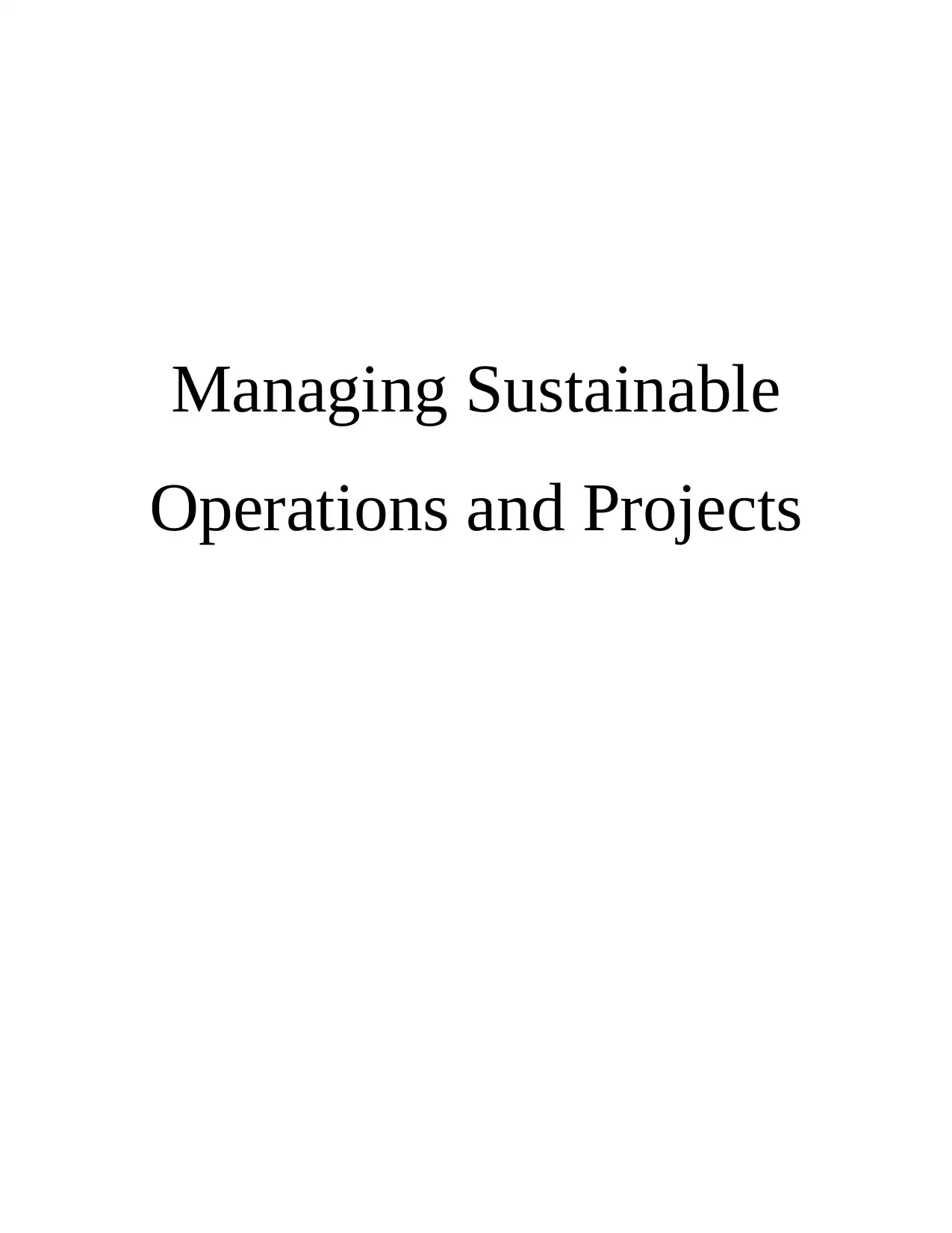
Managing Sustainable
Operations and Projects
Operations and Projects
Paraphrase This Document
Need a fresh take? Get an instant paraphrase of this document with our AI Paraphraser
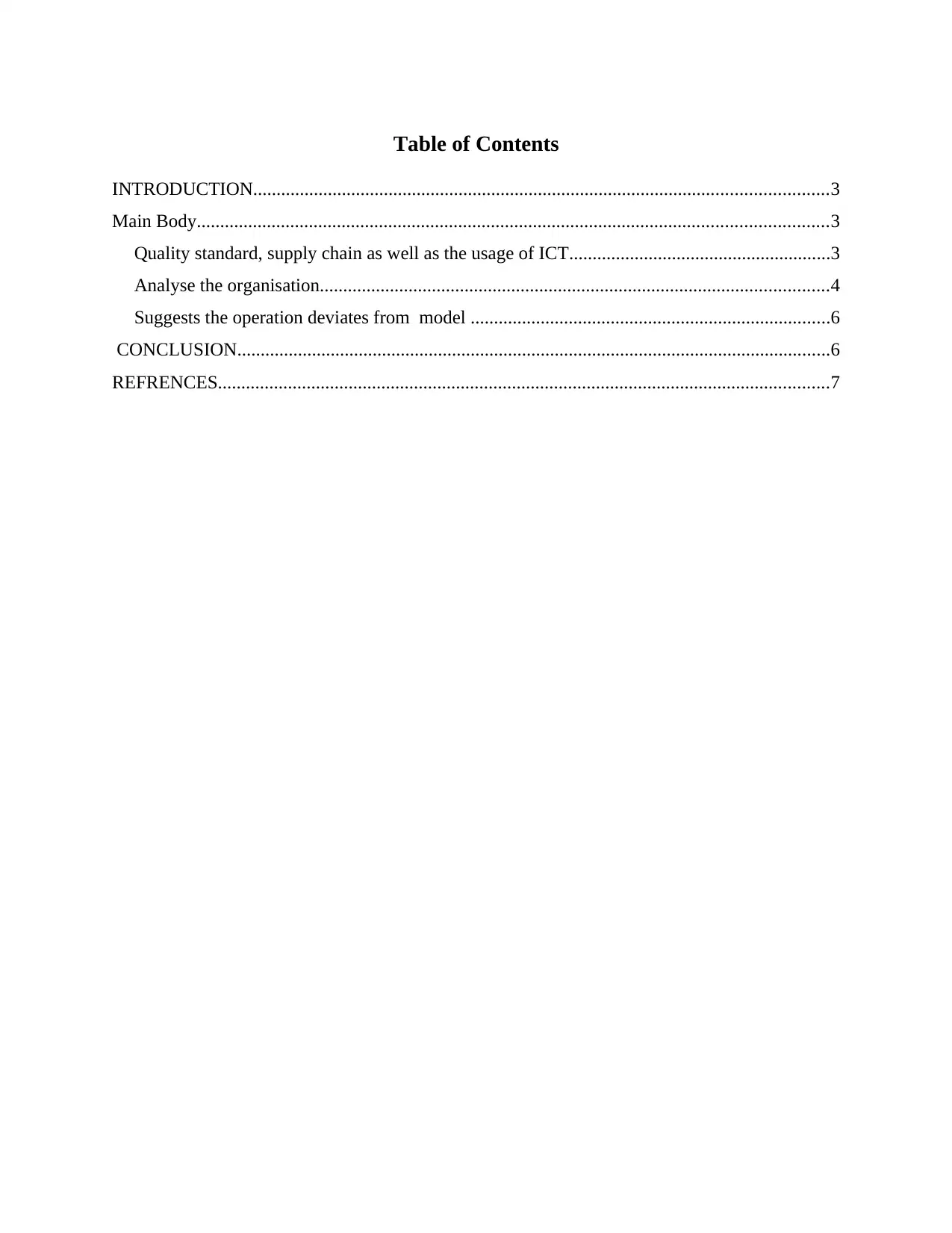
Table of Contents
INTRODUCTION...........................................................................................................................3
Main Body.......................................................................................................................................3
Quality standard, supply chain as well as the usage of ICT........................................................3
Analyse the organisation.............................................................................................................4
Suggests the operation deviates from model .............................................................................6
CONCLUSION...............................................................................................................................6
REFRENCES...................................................................................................................................7
INTRODUCTION...........................................................................................................................3
Main Body.......................................................................................................................................3
Quality standard, supply chain as well as the usage of ICT........................................................3
Analyse the organisation.............................................................................................................4
Suggests the operation deviates from model .............................................................................6
CONCLUSION...............................................................................................................................6
REFRENCES...................................................................................................................................7
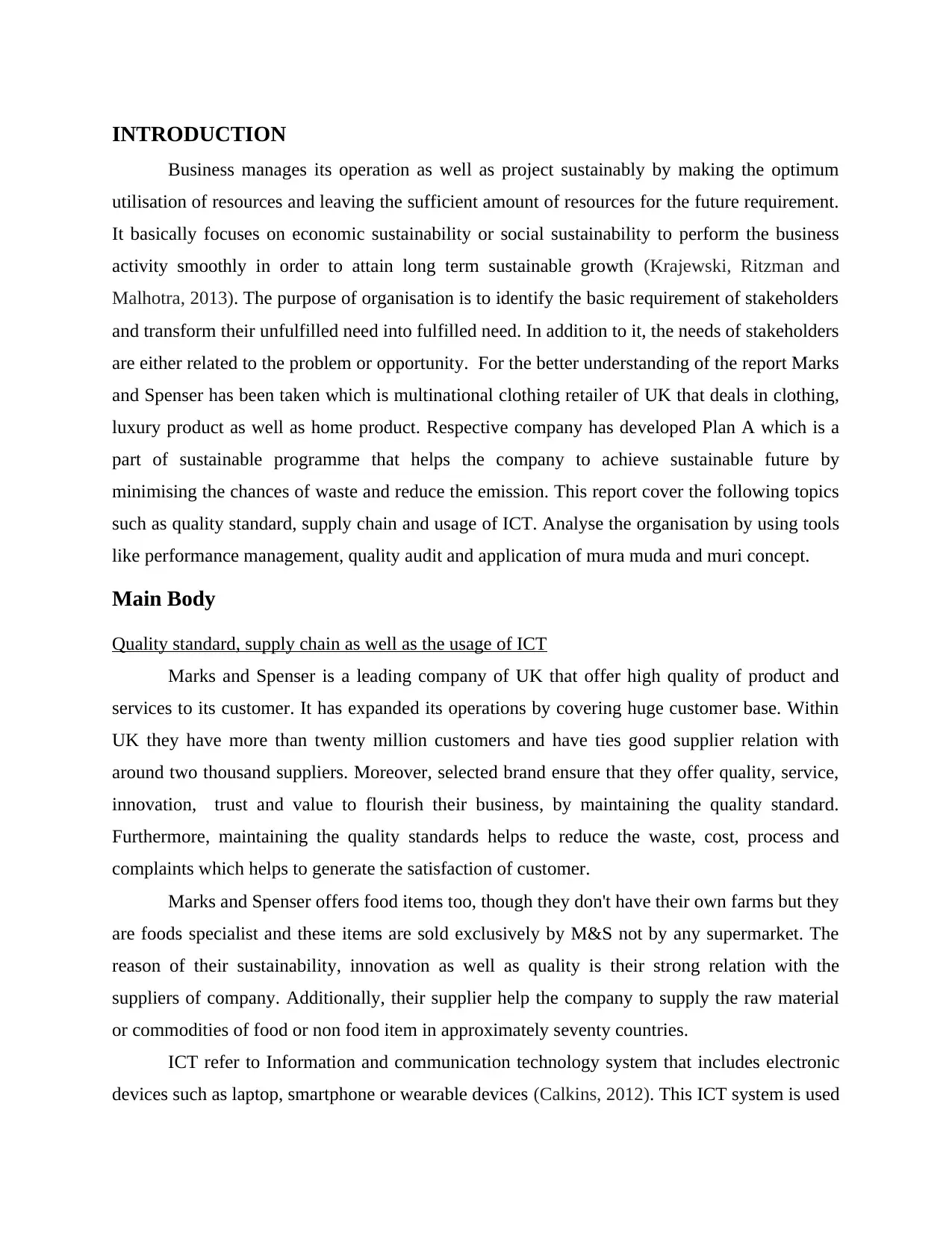
INTRODUCTION
Business manages its operation as well as project sustainably by making the optimum
utilisation of resources and leaving the sufficient amount of resources for the future requirement.
It basically focuses on economic sustainability or social sustainability to perform the business
activity smoothly in order to attain long term sustainable growth (Krajewski, Ritzman and
Malhotra, 2013). The purpose of organisation is to identify the basic requirement of stakeholders
and transform their unfulfilled need into fulfilled need. In addition to it, the needs of stakeholders
are either related to the problem or opportunity. For the better understanding of the report Marks
and Spenser has been taken which is multinational clothing retailer of UK that deals in clothing,
luxury product as well as home product. Respective company has developed Plan A which is a
part of sustainable programme that helps the company to achieve sustainable future by
minimising the chances of waste and reduce the emission. This report cover the following topics
such as quality standard, supply chain and usage of ICT. Analyse the organisation by using tools
like performance management, quality audit and application of mura muda and muri concept.
Main Body
Quality standard, supply chain as well as the usage of ICT
Marks and Spenser is a leading company of UK that offer high quality of product and
services to its customer. It has expanded its operations by covering huge customer base. Within
UK they have more than twenty million customers and have ties good supplier relation with
around two thousand suppliers. Moreover, selected brand ensure that they offer quality, service,
innovation, trust and value to flourish their business, by maintaining the quality standard.
Furthermore, maintaining the quality standards helps to reduce the waste, cost, process and
complaints which helps to generate the satisfaction of customer.
Marks and Spenser offers food items too, though they don't have their own farms but they
are foods specialist and these items are sold exclusively by M&S not by any supermarket. The
reason of their sustainability, innovation as well as quality is their strong relation with the
suppliers of company. Additionally, their supplier help the company to supply the raw material
or commodities of food or non food item in approximately seventy countries.
ICT refer to Information and communication technology system that includes electronic
devices such as laptop, smartphone or wearable devices (Calkins, 2012). This ICT system is used
Business manages its operation as well as project sustainably by making the optimum
utilisation of resources and leaving the sufficient amount of resources for the future requirement.
It basically focuses on economic sustainability or social sustainability to perform the business
activity smoothly in order to attain long term sustainable growth (Krajewski, Ritzman and
Malhotra, 2013). The purpose of organisation is to identify the basic requirement of stakeholders
and transform their unfulfilled need into fulfilled need. In addition to it, the needs of stakeholders
are either related to the problem or opportunity. For the better understanding of the report Marks
and Spenser has been taken which is multinational clothing retailer of UK that deals in clothing,
luxury product as well as home product. Respective company has developed Plan A which is a
part of sustainable programme that helps the company to achieve sustainable future by
minimising the chances of waste and reduce the emission. This report cover the following topics
such as quality standard, supply chain and usage of ICT. Analyse the organisation by using tools
like performance management, quality audit and application of mura muda and muri concept.
Main Body
Quality standard, supply chain as well as the usage of ICT
Marks and Spenser is a leading company of UK that offer high quality of product and
services to its customer. It has expanded its operations by covering huge customer base. Within
UK they have more than twenty million customers and have ties good supplier relation with
around two thousand suppliers. Moreover, selected brand ensure that they offer quality, service,
innovation, trust and value to flourish their business, by maintaining the quality standard.
Furthermore, maintaining the quality standards helps to reduce the waste, cost, process and
complaints which helps to generate the satisfaction of customer.
Marks and Spenser offers food items too, though they don't have their own farms but they
are foods specialist and these items are sold exclusively by M&S not by any supermarket. The
reason of their sustainability, innovation as well as quality is their strong relation with the
suppliers of company. Additionally, their supplier help the company to supply the raw material
or commodities of food or non food item in approximately seventy countries.
ICT refer to Information and communication technology system that includes electronic
devices such as laptop, smartphone or wearable devices (Calkins, 2012). This ICT system is used
⊘ This is a preview!⊘
Do you want full access?
Subscribe today to unlock all pages.

Trusted by 1+ million students worldwide
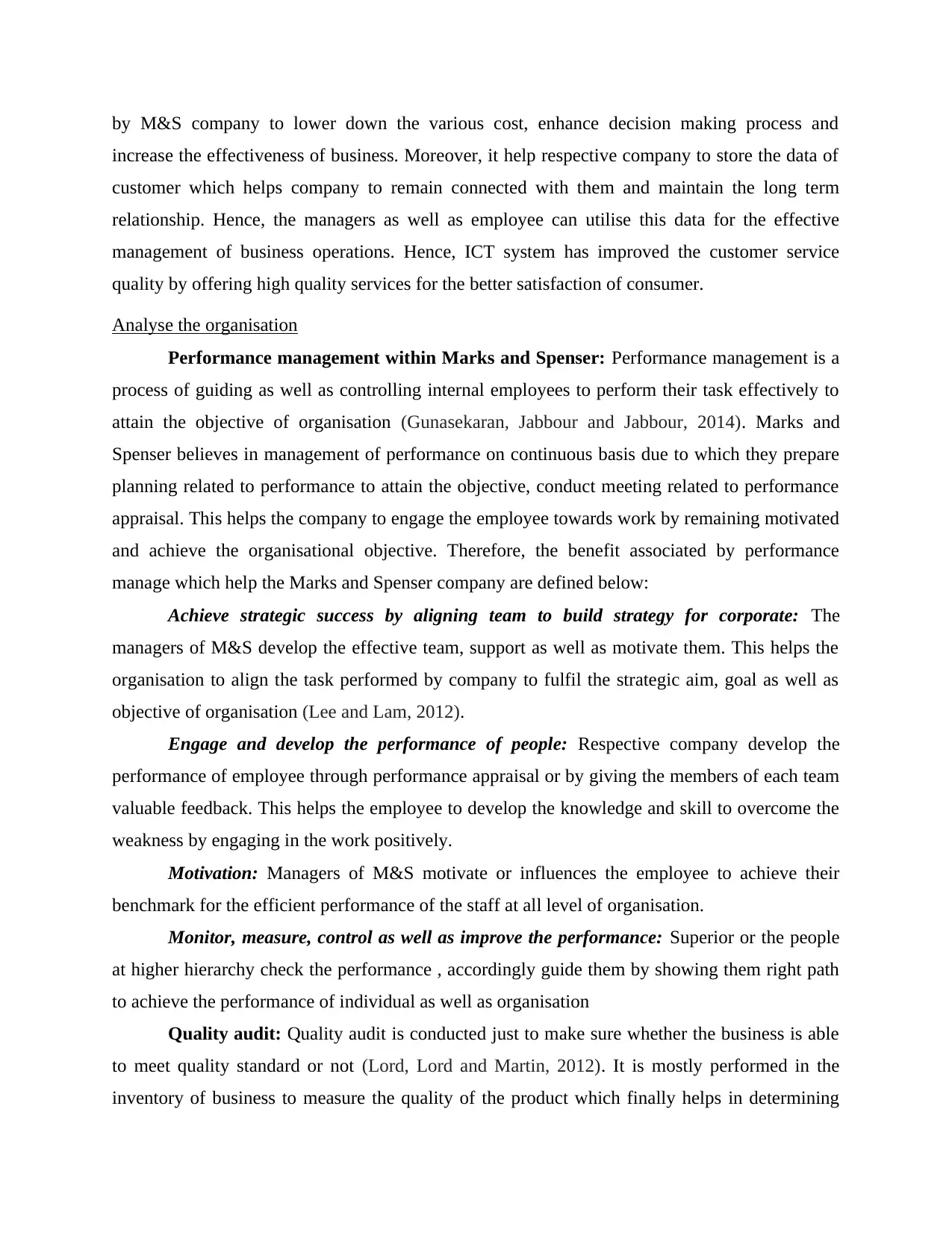
by M&S company to lower down the various cost, enhance decision making process and
increase the effectiveness of business. Moreover, it help respective company to store the data of
customer which helps company to remain connected with them and maintain the long term
relationship. Hence, the managers as well as employee can utilise this data for the effective
management of business operations. Hence, ICT system has improved the customer service
quality by offering high quality services for the better satisfaction of consumer.
Analyse the organisation
Performance management within Marks and Spenser: Performance management is a
process of guiding as well as controlling internal employees to perform their task effectively to
attain the objective of organisation (Gunasekaran, Jabbour and Jabbour, 2014). Marks and
Spenser believes in management of performance on continuous basis due to which they prepare
planning related to performance to attain the objective, conduct meeting related to performance
appraisal. This helps the company to engage the employee towards work by remaining motivated
and achieve the organisational objective. Therefore, the benefit associated by performance
manage which help the Marks and Spenser company are defined below:
Achieve strategic success by aligning team to build strategy for corporate: The
managers of M&S develop the effective team, support as well as motivate them. This helps the
organisation to align the task performed by company to fulfil the strategic aim, goal as well as
objective of organisation (Lee and Lam, 2012).
Engage and develop the performance of people: Respective company develop the
performance of employee through performance appraisal or by giving the members of each team
valuable feedback. This helps the employee to develop the knowledge and skill to overcome the
weakness by engaging in the work positively.
Motivation: Managers of M&S motivate or influences the employee to achieve their
benchmark for the efficient performance of the staff at all level of organisation.
Monitor, measure, control as well as improve the performance: Superior or the people
at higher hierarchy check the performance , accordingly guide them by showing them right path
to achieve the performance of individual as well as organisation
Quality audit: Quality audit is conducted just to make sure whether the business is able
to meet quality standard or not (Lord, Lord and Martin, 2012). It is mostly performed in the
inventory of business to measure the quality of the product which finally helps in determining
increase the effectiveness of business. Moreover, it help respective company to store the data of
customer which helps company to remain connected with them and maintain the long term
relationship. Hence, the managers as well as employee can utilise this data for the effective
management of business operations. Hence, ICT system has improved the customer service
quality by offering high quality services for the better satisfaction of consumer.
Analyse the organisation
Performance management within Marks and Spenser: Performance management is a
process of guiding as well as controlling internal employees to perform their task effectively to
attain the objective of organisation (Gunasekaran, Jabbour and Jabbour, 2014). Marks and
Spenser believes in management of performance on continuous basis due to which they prepare
planning related to performance to attain the objective, conduct meeting related to performance
appraisal. This helps the company to engage the employee towards work by remaining motivated
and achieve the organisational objective. Therefore, the benefit associated by performance
manage which help the Marks and Spenser company are defined below:
Achieve strategic success by aligning team to build strategy for corporate: The
managers of M&S develop the effective team, support as well as motivate them. This helps the
organisation to align the task performed by company to fulfil the strategic aim, goal as well as
objective of organisation (Lee and Lam, 2012).
Engage and develop the performance of people: Respective company develop the
performance of employee through performance appraisal or by giving the members of each team
valuable feedback. This helps the employee to develop the knowledge and skill to overcome the
weakness by engaging in the work positively.
Motivation: Managers of M&S motivate or influences the employee to achieve their
benchmark for the efficient performance of the staff at all level of organisation.
Monitor, measure, control as well as improve the performance: Superior or the people
at higher hierarchy check the performance , accordingly guide them by showing them right path
to achieve the performance of individual as well as organisation
Quality audit: Quality audit is conducted just to make sure whether the business is able
to meet quality standard or not (Lord, Lord and Martin, 2012). It is mostly performed in the
inventory of business to measure the quality of the product which finally helps in determining
Paraphrase This Document
Need a fresh take? Get an instant paraphrase of this document with our AI Paraphraser

whether the business is offering quality to the public. Herein, the above mentioned company
have able to meet the quality standard for food or non food items. As instead of reducing the
essential cost they have made investment on quality planning activities as well as they improve
the process by incurring training cost due to which they have gained renowned position all
around the world.
Muda, Mura and Muri
These are the 3M's of waste that occur while manufacturing the product (Basu, 2014).
These M's are Muda means waste, Muri that means overburden and Mura refer to unevenness.
Muda is a direct obstacle that arises in the flow of goods and services such as ineffective mode of
product from one area to another, storage of too less or too many inventory (Wong and Wong,
2014). Moreover, unnecessary movement of product by machinery or product and increase
chances of defects. Whereas, Muri means employees are not trained properly due to which the
absenteeism rate and breakdown of machinery increases. On other side Mura refer to the uneven
or inconsistent process that leads to over processing or over product that leads to increase in
number of defects (Matos and Silvestre, 2013).
These 3M's does not lead the organisation to achieve its objective as it does not help the
customer to meet its need. Thus, continuous product improvement and quality audit is
implemented by Marks and Spenser which helps the company to minimise the chances of Mura,
Muda and Muri. Respective company provide training and development to its existing as well as
new staff on continuous bases. This helps to enhance the knowledge as well as skill of internal
staff which is utilised in favour of organisation to attain its short as well as long term objective of
organisation within stipulated time period. Along with that continuous improvement
management activity can help in fulfilling the needs of customer by eliminating Muda or waste.
It include close supervision of employee that decreases the chances of over production or number
of defects as well as Muri will get eliminated as training and appraisal process helps to decrease
the turnover rate.
Continuous improvement from the theoretical model of good practice
Continuous is an ongoing process that helps the company to enhance the product or
services by reducing the unnecessary cost. As Marks and Spenser operate at large level so it is
significant for them to increase the productivity and quality by lowering down cost of product.
Thus, along with the adoption of technology or innovation organisation must adopt 3M's concept
have able to meet the quality standard for food or non food items. As instead of reducing the
essential cost they have made investment on quality planning activities as well as they improve
the process by incurring training cost due to which they have gained renowned position all
around the world.
Muda, Mura and Muri
These are the 3M's of waste that occur while manufacturing the product (Basu, 2014).
These M's are Muda means waste, Muri that means overburden and Mura refer to unevenness.
Muda is a direct obstacle that arises in the flow of goods and services such as ineffective mode of
product from one area to another, storage of too less or too many inventory (Wong and Wong,
2014). Moreover, unnecessary movement of product by machinery or product and increase
chances of defects. Whereas, Muri means employees are not trained properly due to which the
absenteeism rate and breakdown of machinery increases. On other side Mura refer to the uneven
or inconsistent process that leads to over processing or over product that leads to increase in
number of defects (Matos and Silvestre, 2013).
These 3M's does not lead the organisation to achieve its objective as it does not help the
customer to meet its need. Thus, continuous product improvement and quality audit is
implemented by Marks and Spenser which helps the company to minimise the chances of Mura,
Muda and Muri. Respective company provide training and development to its existing as well as
new staff on continuous bases. This helps to enhance the knowledge as well as skill of internal
staff which is utilised in favour of organisation to attain its short as well as long term objective of
organisation within stipulated time period. Along with that continuous improvement
management activity can help in fulfilling the needs of customer by eliminating Muda or waste.
It include close supervision of employee that decreases the chances of over production or number
of defects as well as Muri will get eliminated as training and appraisal process helps to decrease
the turnover rate.
Continuous improvement from the theoretical model of good practice
Continuous is an ongoing process that helps the company to enhance the product or
services by reducing the unnecessary cost. As Marks and Spenser operate at large level so it is
significant for them to increase the productivity and quality by lowering down cost of product.
Thus, along with the adoption of technology or innovation organisation must adopt 3M's concept

to gain the advantage of effectiveness as well as efficiency. Therefore, continuous training must
be provided to the internal employees to enhance the retention and loyalty of employee for the
organisation.
Suggests the operation deviates from model
Marks and Spenser which is multinational brand provide specialist premium quality of
product globally. So it is essential for company to adopt continuous development method though
it is time taking but increases the productivity as well as profitability of the company. It also help
the company to overpower their competitors by gaining competitive advantage over competitors.
Moreover, they must develop their product by elimination 3M's that is Muda, Muri and
Muri. As it helps the selected company in following ways such as adequate flow of goods and
services, easy transportation from one place to another that saves the energy as well as time of
workforce. Along with that it decreases the chances of defects, turnover rate and breakdown of
machinery. Therefore, elimination of such cost helps the organisation to save its time and cost by
increasing the effectiveness as well as efficiency.
CONCLUSION
From the above report it has been determined that the strategies for sustainability
management or operations as well as projects is growing significantly. Thus, the operation
management includes planning, designing, control, improve the decision and processes
associated with the operation management that helps in the implication of strategic decision and
processes. Moreover, company should continuously develop its performance to enhance its
productivity and eliminate the Mura, Muri and Muda cost at the time of production of goods.
Furthermore, organisation should able to meet the quality standard of the product to achieve long
term sustainable development.
be provided to the internal employees to enhance the retention and loyalty of employee for the
organisation.
Suggests the operation deviates from model
Marks and Spenser which is multinational brand provide specialist premium quality of
product globally. So it is essential for company to adopt continuous development method though
it is time taking but increases the productivity as well as profitability of the company. It also help
the company to overpower their competitors by gaining competitive advantage over competitors.
Moreover, they must develop their product by elimination 3M's that is Muda, Muri and
Muri. As it helps the selected company in following ways such as adequate flow of goods and
services, easy transportation from one place to another that saves the energy as well as time of
workforce. Along with that it decreases the chances of defects, turnover rate and breakdown of
machinery. Therefore, elimination of such cost helps the organisation to save its time and cost by
increasing the effectiveness as well as efficiency.
CONCLUSION
From the above report it has been determined that the strategies for sustainability
management or operations as well as projects is growing significantly. Thus, the operation
management includes planning, designing, control, improve the decision and processes
associated with the operation management that helps in the implication of strategic decision and
processes. Moreover, company should continuously develop its performance to enhance its
productivity and eliminate the Mura, Muri and Muda cost at the time of production of goods.
Furthermore, organisation should able to meet the quality standard of the product to achieve long
term sustainable development.
⊘ This is a preview!⊘
Do you want full access?
Subscribe today to unlock all pages.

Trusted by 1+ million students worldwide
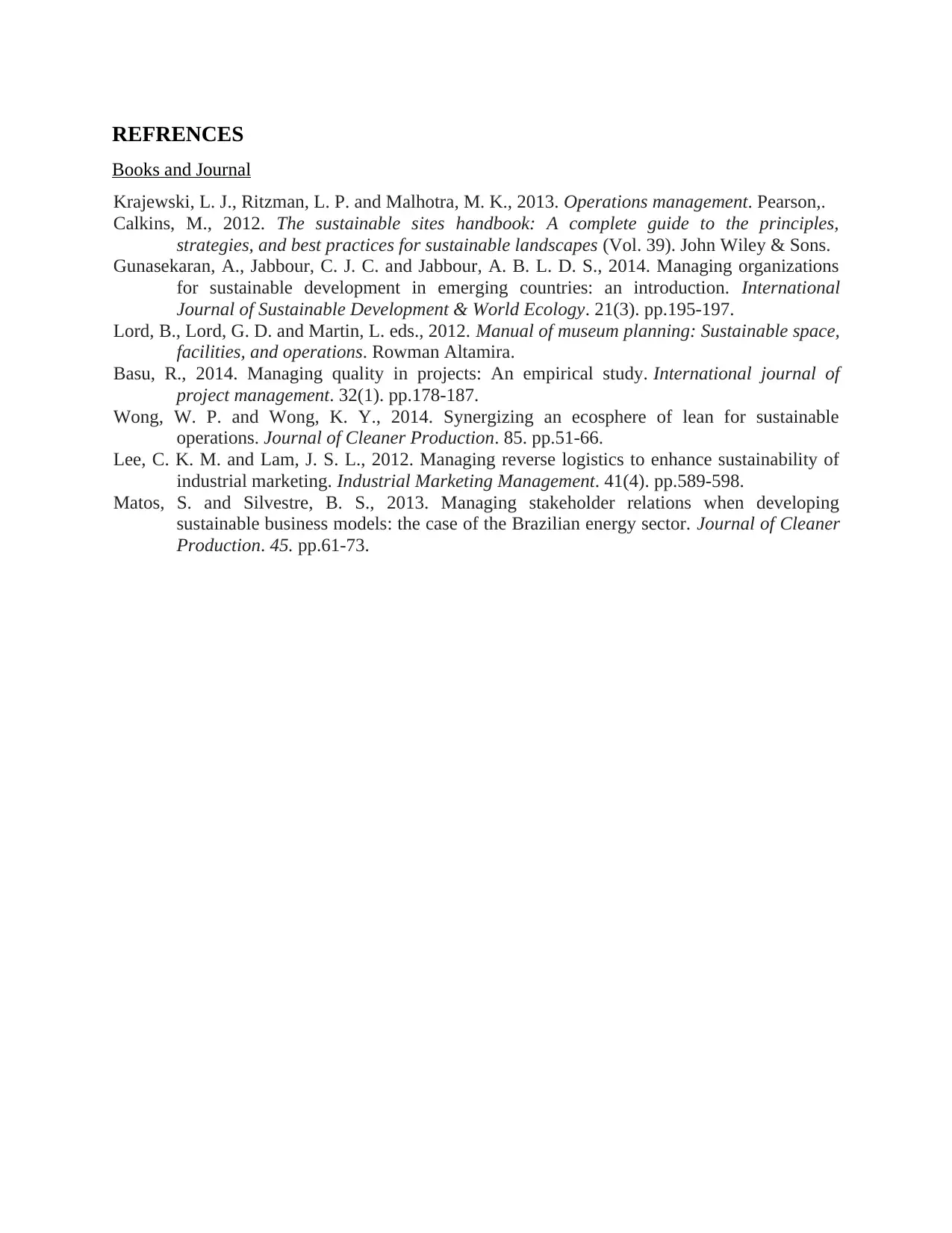
REFRENCES
Books and Journal
Krajewski, L. J., Ritzman, L. P. and Malhotra, M. K., 2013. Operations management. Pearson,.
Calkins, M., 2012. The sustainable sites handbook: A complete guide to the principles,
strategies, and best practices for sustainable landscapes (Vol. 39). John Wiley & Sons.
Gunasekaran, A., Jabbour, C. J. C. and Jabbour, A. B. L. D. S., 2014. Managing organizations
for sustainable development in emerging countries: an introduction. International
Journal of Sustainable Development & World Ecology. 21(3). pp.195-197.
Lord, B., Lord, G. D. and Martin, L. eds., 2012. Manual of museum planning: Sustainable space,
facilities, and operations. Rowman Altamira.
Basu, R., 2014. Managing quality in projects: An empirical study. International journal of
project management. 32(1). pp.178-187.
Wong, W. P. and Wong, K. Y., 2014. Synergizing an ecosphere of lean for sustainable
operations. Journal of Cleaner Production. 85. pp.51-66.
Lee, C. K. M. and Lam, J. S. L., 2012. Managing reverse logistics to enhance sustainability of
industrial marketing. Industrial Marketing Management. 41(4). pp.589-598.
Matos, S. and Silvestre, B. S., 2013. Managing stakeholder relations when developing
sustainable business models: the case of the Brazilian energy sector. Journal of Cleaner
Production. 45. pp.61-73.
Books and Journal
Krajewski, L. J., Ritzman, L. P. and Malhotra, M. K., 2013. Operations management. Pearson,.
Calkins, M., 2012. The sustainable sites handbook: A complete guide to the principles,
strategies, and best practices for sustainable landscapes (Vol. 39). John Wiley & Sons.
Gunasekaran, A., Jabbour, C. J. C. and Jabbour, A. B. L. D. S., 2014. Managing organizations
for sustainable development in emerging countries: an introduction. International
Journal of Sustainable Development & World Ecology. 21(3). pp.195-197.
Lord, B., Lord, G. D. and Martin, L. eds., 2012. Manual of museum planning: Sustainable space,
facilities, and operations. Rowman Altamira.
Basu, R., 2014. Managing quality in projects: An empirical study. International journal of
project management. 32(1). pp.178-187.
Wong, W. P. and Wong, K. Y., 2014. Synergizing an ecosphere of lean for sustainable
operations. Journal of Cleaner Production. 85. pp.51-66.
Lee, C. K. M. and Lam, J. S. L., 2012. Managing reverse logistics to enhance sustainability of
industrial marketing. Industrial Marketing Management. 41(4). pp.589-598.
Matos, S. and Silvestre, B. S., 2013. Managing stakeholder relations when developing
sustainable business models: the case of the Brazilian energy sector. Journal of Cleaner
Production. 45. pp.61-73.
1 out of 7
Related Documents
Your All-in-One AI-Powered Toolkit for Academic Success.
+13062052269
info@desklib.com
Available 24*7 on WhatsApp / Email
![[object Object]](/_next/static/media/star-bottom.7253800d.svg)
Unlock your academic potential
Copyright © 2020–2025 A2Z Services. All Rights Reserved. Developed and managed by ZUCOL.




